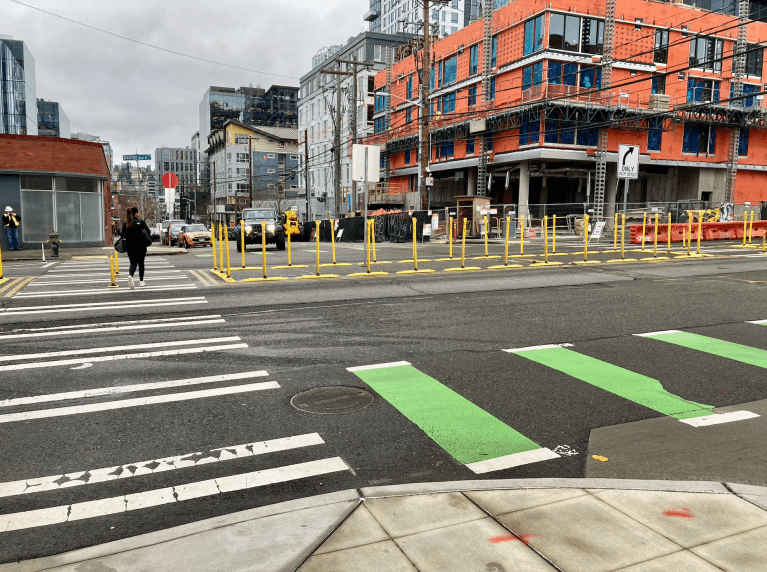Kevin Dave, Officer Who Struck and Killed 23-Year-Old Student in 2023, Appeals His Firing
"It is inconceivable to me" that Dave didn't know he shouldn't have driven three times the speed limit on a dark, rainy night in January, interim police chief Sue Rahr wrote.

By Erica C. Barnett
Kevin Dave, the Seattle police officer who struck and killed 23-year-old pedestrian Jaahnavi Kandula in January 2023, is appealing his firing and seeking reinstatement as a police officer, PubliCola has learned. Interim police chief Sue Rahr fired Dave earlier this month, noting that he had violated several SPD policies on emergency driving as well as the law.
Dave was driving 74 miles an hour—about three times the speed limit—on a wet, rainy night two years ago when he hit Kandula, who had just entered a marked crosswalk on Dexter Ave..
Last year, the King County Prosecuting Attorney's Office declined to prosecute Dave, finding that he was responding to a "legitimate emergency"—a reported overdose in South Lake Union. Former police chief Adrian Diaz claimed at the time that Dave was responding "as an EMT" with training in overdose reversal. However, a disciplinary report signed by Rahr in October found that Dave met all three of the requirements for vehicular homicide—regardless of whether the prosector's office, using a higher standard of proof, charged him with a crime.
Dave told OPA investigators that he was "responding to a 'life or death situation,'" the report says, and that he would not have been able to reverse the overdose in time if he had driven more slowly. However, PubliCola's reporting revealed that the person who called 911 to report the "overdose" was, in fact, "freaking out" after taking too much cocaine; he walked down to the street outside his building before calling 911 and was lucid and relatively calm.
Overdose reversals—which involve rescue breathing or Narcan— are for opiates, and their purpose is to get an unresponsive person breathing again. There is no such thing as an overdose reversal for cocaine.
According to Dave's discipline report, he told Office of Police Accountability investigators that in the seconds prior to the collision, he "saw a 'long straight road' ahead [and] had a 'clear line of sight,'" so didn't feel the need to activate his siren before accelerating rapidly. (Dave also claimed he wanted to avoid community complaints about the noise).
But, Rahr's report notes, "OPA found that you drove faster than was reasonably necessary to safely arrive at the scene under the circumstances, citing, again, the multiple crosswalks and reflective signs indicating the possible presence of crossing pedestrians."
As for possible "community complaints" about siren noise, the report says, "It is difficult to imagine a more appropriate circumstance for using a continuous siren than the factors [you] faced."
"When OPA noted that an independent investigative entity concluded that the collision might have been avoided if you had been traveling at 50 MPH, you described this as 'hindsight' and stated that if you 'had been doing 20 miles an hour, a collision wouldn't have occurred, but that speed isn't reasonable for someone who's going to have brain damage in under five minutes because of an overdose," the report continued. Dave also told investigators that Kandula's "inattention" and the fact that she "ran out in front of" his car were partly to blame for her death.
"You said: 'I'm not a jerk, I haven't s[o]wed mistrust in the community," Rahr's report notes, as "an apparent attempt to distinguish your conduct from that of" Daniel Auderer, the officer who was fired after joking with his fellow police union leader Mike Solan about Kandula's death.
Dave's attorney argued that he couldn't possibly have anticipated a pedestrian stepping out into a crosswalk on Dexter Ave., and argued that he was dazzled by all the signs, lights, and reflective construction barriers that lined Dexter Ave. at the time. But Rahr said these factors "should have caused you to slow down," not speed up.
"The signs warning you that pedestrians might be crossing ahead, the reflection of your lights off of those signs, the oncoming headlights in your eyes, the construction barriers lining and narrowing the lane and inhibiting your view, and the presence of well-marked crosswalk itself, all should have caused you to proceed cautiously rather than speed through the obvious hazard zone. "
"The most basic foundational principal of emergency vehicle operation is your duty to exercise due care for the safety of all persons when responding to an emergency. It is inconceivable to me that you didn't understand that at the time of the collision," Rahr wrote.
"Or that you did not understand the risk to pedestrians that YOU created by driving through a crosswalk at freeway speed, on a dark, wet night, through a construction zone with limited visibility," Rahr's report continued. "The risk you created FAR outweighs the risk to a possible overdose victim suffering potential brain damage if you had arrived a few minutes later so you could drive at a safer speed. As it was, you never made it to that call at all."
The Public Safety Civil Service Commission will hold an initial hearing on Dave's appeal on January 16, but it could be months before the full commission considers his request for reinstatement. Dave remained a paid SPD employee for two years after killing Kandula.





As far as I'm concerned every point that Sue Rahr made is absolutely correct, and furthermore this guy should be serving time for negligence, reckless driving, and probably vehicular homicide. He had absolutely no business driving that fast in such a densely-populated, pedestrian-heavy area.
That he is asking to be reinstated shows an absolute lack of remorse on his part, and is disqualifying.